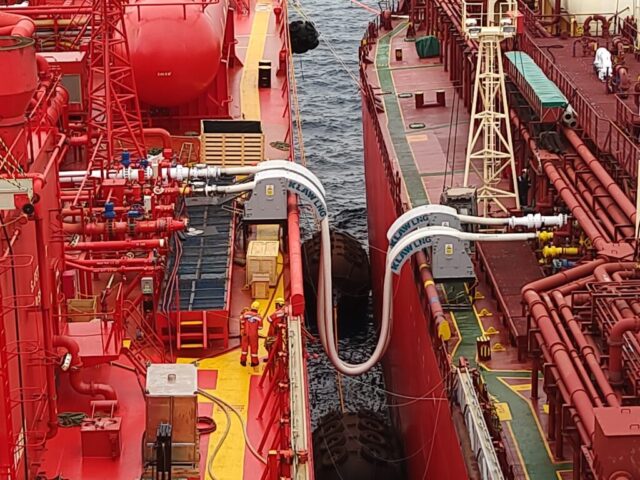Ship-to-ship ammonia transfers pave the way for ammonia bunkering in the Pilbara
By Julian Atchison on September 23, 2024
GCMD, MOL, Navigator Gas, Yara and others partner for trial at Port of Dampier

Click to expand. Full details of the five-day operation, simulating ammonia bunker transfer within port for the first time. Source: GCMD.
Led by the Global Centre for Maritime Decarbonisation, a consortium has successfully executed a ship-to-ship ammonia transfer in outer anchorage, simulating ammonia bunker fuel operations within a port for the first time. To mimic future ammonia bunkering scenarios, the consortium utilised a handysize and a midsize gas carrier with capacities that are similar to that expected of ammonia bunker vessels. Two transfers were completed between the Green Pioneer (a Mitsui O.S.K. Lines vessel) and the Navigator Global (a Navigator Gas vessel), with 2,700 tons transferred back-and-forth between the vessels over the course of a day.
The full operation occurred over the course of five days, with the smaller supply vessel Coral Knight and two Rio Tinto tugboats assisting. James Fisher Fendercare was contracted to execute the actual transfer operations, with Yara providing the ammonia cargo from its plant near Karratha. Other consortium partners include bp, BHP, and Eastern Pacific Shipping (EPS), all of whom are Strategic Partners of GCMD; Gard, an Impact Partner, and the Technology Centre for Offshore and Marine, Singapore (TCOMS).
Yara and Pilbara Ports Authority launched a feasibility study for ammonia bunkering in 2022, and a Lloyd’s Register-led report revealed ammonia bunkering was economically and technically feasible at the various Pilbara Ports, including two of the world’s largest bulk export ports (Dampier and Hedland, from which 39% of the world’s seaborne iron ore exports originate). The Global Maritime Forum also highlighted the enormous potential of the Pilbara to act as one end of a green iron ore shipping corridor from 2028, powered by ammonia fuel.
Safety preparations

Click to expand. Hose connections between the Green Pioneer and the Navigator Global during the ammonia transfer. Source: GCMD.
Safety measures included the use of emergency release couplings, emergency shutdown devices (amongst other safety equipment), and the implementation of hot-gas and nitrogen purging procedures after each ammonia transfer. Procedures were developed in close collaboration with safety consultants, ship-to-ship transfer service providers, Pilbara Ports, Australian Government agencies, operators of ammonia vessels, and Yara, the fuel provider.
In May 2024, a series of safety workshops laid the groundwork for the risk assessments. DNV conducted Hazard Identification (HAZID) and Hazard and Operability (HAZOP) studies. HAZID studies indicated no high-risk items across the seven different risk nodes that were identified from approach to unmooring, taking into account the existing preventive and mitigative measures as well as the implementation of the study recommendations. Similarly, HAZOP studies on the transfer operations reveal no high-risk items across three different transfer nodes.
These HAZID and HAZOP studies formed the basis for a Pilbara-specific draft emergency response plan, completed by Oil Spill Response Limited (OSRL) and partners BlueTack and Stream Marine Technical. As part of the recommendation, the Coral Knight (an ex-fire-fighting tug), was deployed to assist in the event of an emergency. All findings and recommendations were presented to the Australian Maritime Safety Authority (AMSA), the Department of Transport (DoT), and the Department of Fire and Emergency Services (DFES), who provided additional guidance on operational safety.
This ammonia transfer pilot is a testament to the deliberate collaboration and rigorous planning of all parties involved. Beyond addressing the technical and operational challenges, executing this pilot required us to navigate complex commercial landscapes, including securing vessels and managing cargo transfer, as well as uncertainties and spur-of-the-moment hiccups that arise during operations….This pilot marks a crucial step towards readying the ecosystem for using ammonia as a marine fuel, paving the way for eventual bunkering when ammonia-fuelled vessels become available.
Professor Lynn Loo, CEO, GCMD in her organisation’s official press release, 16 Sept 2024
The Pilbara is an obvious beachhead for investment in green fuels. It has all the ingredients for success: a vast industrial base, stable demand, ample access to solar and wind energy, and world-leading export infrastructure. The scale of maritime operations in the Pilbara, together with its critical role in supplying half the world’s iron ore, make it the centrepiece of efforts to decarbonise the world’s bulk shipping fleet. Ammonia is already produced, stored and exported in industrial quantities from the Port of Dampier. The GCMD/Yara Clean Ammonia trial leveraged that experience to incrementally advance the potential of ammonia as a green marine fuel, to the benefit of others across the global maritime sector.
Samuel McSkimming, CEO, Pilbara Ports in GCMD’s official press release, 16 Sept 2024
The demonstration marks the third successful ship-to-ship ammonia transfer in 2024 intended to simulate bunker operations. In April, Navigator Gas oversaw a 25,000 ton transfer near the Port of Ngqura in South Africa, and in July Trafigura reported a successful operation in the Straits of Gibraltar.